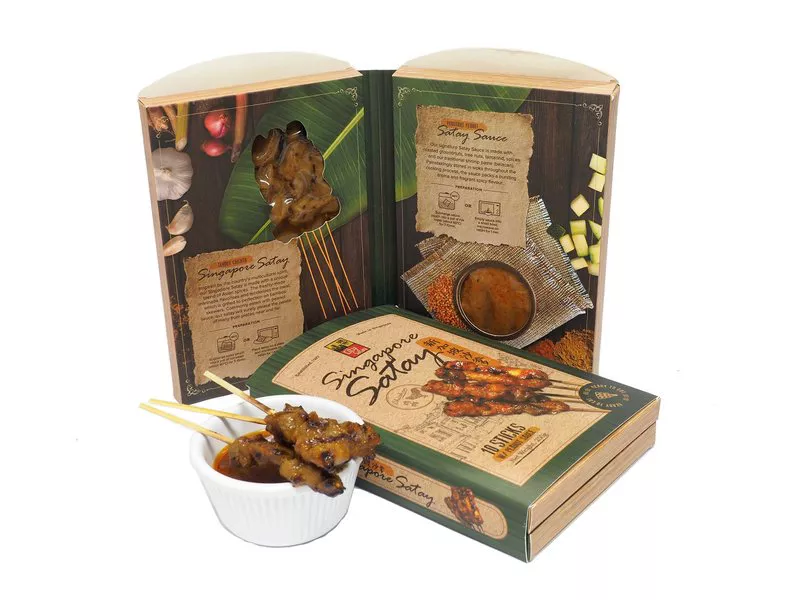25 June 2020
Satay, or grilled meat skewers, are a popular snack for many in Singapore. Mr Wong Kam Sooi, the factory manager of City Satay, reminisces about the origins of this delicious treat and reveals how the company he works for is keeping this tradition alive for the next generation.
Singapore’s culinary culture of street food goes a long way back. Many might recall seeing old black and white photographs of pushcart hawkers peddling their wares on the streets while older Singaporeans may even remember buying and eating food from these makeshift stalls. A mainstay of street hawkers were the satay men, who would grill these skewers over portable charcoal grills, imparting a delicious, smokey flavour to the meat.
“I remember most fondly the times I would buy a bunch of freshly grilled satay to enjoy with my family back home. This is why when I think about satay, my memories are filled with the warmth of home and family,” said Mr. Wong Kam Sooi, the factory manager of City Satay.
Many of Singapore’s satay sellers can trace their roots to the Satay Club, which was once located at the Esplanade. Over time, members of the Satay Club dispersed and set up stalls in Lau Pa Sat, Boon Tat Street and Toa Payoh Centre, destinations which continue to be remembered for having good satay.
However, in modern Singapore, as fewer people in the next generation choose to become hawkers, satay sellers are reducing in numbers too.
Thankfully, food brands like City Satay continue to keep this delicious treat alive by producing satay according to tried and tested traditional recipes to safeguard this piece of culinary heritage for generations to come.
Said to originate from Java, Indonesia, satay was introduced here through Muslim traders. Over the years, the marinade used in Singapore versions have evolved to cater to local tastes. “The secret to preserving the iconic local flavours of satay lies in the blend of spices from Southeast Asia, such as cumin, fennel, turmeric, five-spice curry powder,” said Mr. Wong. A peanut sauce is commonly used as a dip with local satay.
City Satay’s founder began making and selling manually marinated and skewered satay in 1987 at a Bedok food stall based on her own recipe. As the brand grew in popularity, she began to offer satay distribution to other hawkers and food businesses. Today, City Satay has grown into a major food manufacturer in Singapore and is the preferred satay supplier to many in the food and beverage industry.
Even though the satay is now produced in much greater quantities in a factory, City Satay is careful to ensure the authentic flavours and spices of this dish remain the same. “There isn’t much of a difference between grilling satay at the factory with machines and the stall in the hawker center,” said Mr. Wong, who has worked at City Satay for 14 years. “The main factor in maintaining the authentic taste is to control the grilling temperature and cooking duration so that the satay tastes like it has been cooked over a fire.”
Thanks to City Satay, home chefs can also get their hands on satay that they can easily whip up at home. To achieve a similar flavour to stall-bought satay, Mr. Wong recommends, “At home, use baking trays when grilling them in an oven or an air fryer. Alternatively, you can also deep fry the satay. For a slightly burnt flavour, you can extend the cooking time a little longer.”
Even non-cooks can enjoy City Satay at home. The brand has a ready-to-eat chicken satay that has already been marinated and grilled to perfection, so that it can be eaten straight out of the packet even without being reheated.
Whichever your choice, you can make a meal out of your satay by pairing the meat with vegetables and fruits such as cucumber, green onion, pineapple and if available, Malay rice dumplings (ketupat). Wash your meal down with “cooling” local beverages such as coconut water or sugar cane water, to counter the “heat” of grilled meat.
Most of all, do enjoy your satay in the company of friends and family–whether in person or via a video call. Mr Wong recalls, “When I eat satay, I think about old pictures of my family and I eating together, chatting happily, and enjoying each other’s presence.” So, when you savour this dish with your loved ones, you too are playing a role in preserving the communal spirit of this heritage street food.














